
The Merino is a breed or group of breeds of domestic sheep, characterised by very fine soft wool. It was established in Spain near the end of the Middle Ages, and was for several centuries kept as a strict Spanish monopoly; exports of the breed were not allowed, and those who tried risked capital punishment. During the eighteenth century, flocks were sent to the courts of a number of European countries, including France, Hungary, the Netherlands, Prussia, Saxony and Sweden.

Sheep farming or sheep husbandry is the raising and breeding of domestic sheep. It is a branch of animal husbandry. Sheep are raised principally for their meat, milk, and fiber (wool). They also yield sheepskin and parchment.
Polwarth is a breed of sheep that was developed in Victoria (Australia) during 1880. They were of one-quarter Lincoln and three-quarters Merino bloodlines. They are large, predominantly polled sheep with long, soft, quite fine wool and produce good meat carcasses. They were developed in an attempt to extend the grazing territory of sheep because the Merino was found lacking in hardiness in this respect. A dual-purpose breed with a major emphasis on wool production. Richard Dennis, of Tarndwarncoort in south west Victoria, bred the Polwarth, first known as Dennis Comebacks. Descendants of Richards Dennis continue to grow Polwarth wool at Tarndwarncoort, maintaining the original bloodlines in a flock referred to as the "Blue Dots".

The Border Leicester is a British breed of sheep. It is a polled, long-wool sheep and is considered a dual-purpose breed as it is reared both for meat and for wool. The sheep are large but docile. They have been exported to other sheep-producing regions, including Australia and the United States.

The Romney, formerly called the Romney Marsh sheep but generally referred to by the local farmers as the Kent, is a breed of sheep originating in England. The Romney is a "long-wool" breed recognized in England by 1800. Exported to other continents, the Romney is an economically important sheep breed, especially to the sheep-meat and wool export trades of New Zealand.
The Finnish Landrace, Finn or Finnsheep is a breed of domestic sheep native to Finland. It is one of several Northern European short-tailed sheep breeds, but is notable for its high incidence of multiple births – it is common for a ewe to have three, four, or even five lambs at once.
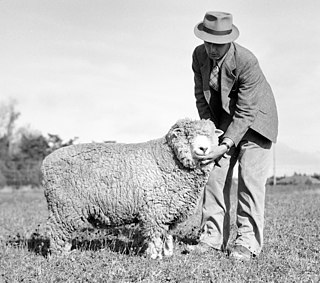
The Corriedale is a New Zealand breed of sheep. It was bred from about 1882 in the South Island by James Little, who cross-bred Merino and Lincoln Longwool sheep. The breed was officially recognised in 1911. It has been exported to Australia and to many countries in Africa, Asia, Europe and North and South America. In 2021 it was reported from twenty-five countries, and the total population was estimated at just over 5 million.

The Dorset Horn is an endangered British breed of domestic sheep. It is documented from the seventeenth century, and is highly prolific, sometimes producing two lambing seasons per year. Among British sheep, it is the only breed capable of breeding throughout the winter.

The St Croix is a breed of domestic sheep native to the U.S. Virgin Islands and named for the island of Saint Croix. They are often also called Virgin Island White because those that were imported into North America were selected for white coloration. On the Island of St. Croix, they come in shades of brown, white, and black.
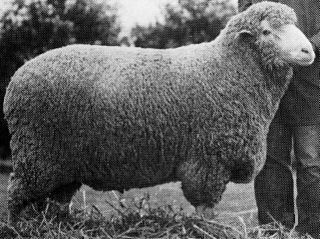
Bond sheep are an Australian sheep breed that was developed around 1909 near Lockhart, New South Wales by Thomas Bond when he mated Saxon-Peppin Merino ewes to stud Lincoln rams for primarily wool production. The resulting progeny was selected on the basis that they would be more suited to the Riverina environment. Initially these sheep were known as ‘the Commercial Corriedale’.

The raising of domestic sheep has occurred in nearly every inhabited part of the earth, and the variations in cultures and languages which have kept sheep has produced a vast lexicon of unique terminology used to describe sheep husbandry.

The Poll Dorset, a short-wool, meat-producing sheep, was developed in Australia between 1937 and 1954 with the aim of breeding a true Dorset type sheep without horns. The poll gene was introduced into Dorset Horn flocks from two other polled breeds and following a strict back-mating programme achieved close to 100% of Dorset Horn blood. Its main distinguishing features are its hornless appearance, long, lean square body set on short legs, pink skin and 'spongy' short-stapled wool. The Poll Dorset produces a fleece of white, dense downs type wool of 30 microns fibre diameter and it has a white wool-free face. The breed was developed at a property called Valmore in Whitemore, Tasmania, a noted centre for pedigree livestock stud farms. The Poll Dorset resulted from the introduction of Corriedale and Ryeland blood into the Dorset Horn.

The Blackhead Persian is a fat-tailed breed of domestic sheep from Africa. The sheep is originally from Somalia and a direct descendant of the Somali sheep. The breed is also a type of hair sheep, meaning they do not grow wool and tolerate heat better than wooled breeds and are raised primarily for meat. The Blackhead Persian has a white body and, as their name would suggest, an entirely black head.
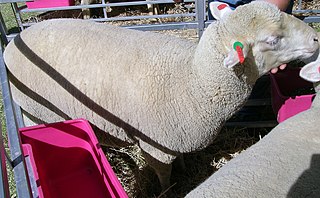
The South African Meat Merino or SAMM is a wool and meat sheep originating in South Africa, but now found throughout the world.
The British Milksheep is a robust, dual-purpose sheep commonly known for its milking characteristics.

The Wiltipoll is a breed of polled domestic sheep that was developed in Australia from Wiltshire Horn sheep with the infusion of Border Leicester, Perendale, Poll Dorset, and Poll Merino genetics, that are raised for meat.
The Van Rooy, also known as the Van Rooy White Persian, is a breed of domestic sheep native to South Africa. The Van Rooy was first developed in 1906 by J. C. van Rooy, a South African Senator and farmer in the Bethulie district. The Van Rooy is cross between indigenous Ronderib Afrikaner sheep, and Rambouillets. It is a fat-tailed sheep and also a hair sheep, removing the need for shearing and crutching. They are generally kept for meat production, and are very well-suited to arid climates. Van Rooys are polled, have drooping ears, and are entirely white. The breed is relatively rare, even in South Africa, but has also been exported to Namibia and Zimbabwe.

The Australian White (AUW) sheep breed, originating from Australia, is known for its coarse wool and specialization in mutton production. This breed combines genetic traits from four distinct sheep breeds: Dorper, Van Rooy, Polled Dorset, and Texel. AUW sheep offer advantages such as strong stress resistance, rapid growth, and are low-maintenance animals. With applications in both meat and wool production, AUW sheep present an opportunity for crossbreeding with local sheep varieties, aiming to enhance meat quality and boost production efficiency
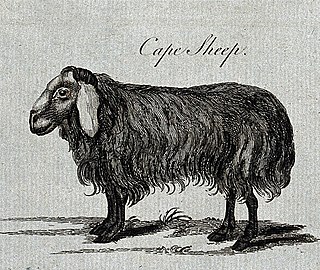
The Afrikaner sheep is a breed of fat tailed, hair sheep indigenous to South Africa.
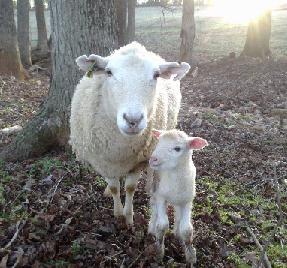
The Polled Dorset is an American breed of domestic sheep. It is a polled (hornless) variant of the British Dorset Horn. It was developed at the North Carolina State University Small Ruminant Unit in the 1950s after a genetic mutation led to the birth of a polled ram. After some years of breeding work, a true-breeding polled strain was established.




















